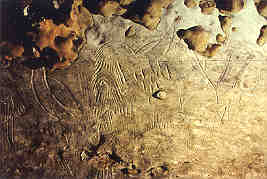A huge Cave

One of the largest caves in the region, Rouffignac is a development of about eight kilometres of galleries on three levels with corridors unusually voluminous in the Périgord. Some of its galleries are ten metres high, others a dozen metres wide. The whole of the cave is hollowed out in a full of flint nodules cretaceous limestone. Apart from a small brook, running along the deepest galleries, most of the network is totally fossil. Water dug mainly during the tertiary geological area. The network is considered as being dry for two or three million years.
cave occupied by bears
Cave bears were probably the first to use this network. Numerous traces of their repetitive passages remain: countless claw marks on walls and ceilings and bear dens in the clayey ground of some of the galleries. Nevertheless, bones are surprisingly rare.
The Magdalenian artists
Mammoth is the main theme in Rouffignac. 158 of those pachyderms are shown on this network’s walls and ceilings. Despite the grand prestige this animal holds in our spirits, it was seldom represented by the prehistoric artists, generally to the benefit of horse and bison .Thus, when 350 ornamented caves are known in Western Europe, about a third of the mammoth representations are in Rouffignac. That is why the place is commonly nicknamed "the 100 mammoths cave". This choice made by the prehistoric artists is even more surprising that mammoth bones are rarely found in the South- Western France. This obviously adds mystery to the cave’s ornamentation.
Engraving of the Patriarch
This is one of the most spectacular among the numerous mammoth representations in the cave. It shows an elderly animal (as shown by the tusks length) and is a good example of Rouffignac art’s legibility. It also highlights the spontaneity of the artists’ gestures.
A set of mammoth and ibex.
As usually observed in the prehistoric art, other subjects go with the central theme. This phenomenon is particularly observable on the Great Ceiling, where a whirl of 65 animal figures dominates a shaft leading to the lower levels. There, mixed to the commonly seen horses and bisons, rhinoceros -extremely rare in the prehistoric art- can be admired, as well as ibex, like those surrounding the Grandfather (one of the most complete mammoth figures in the cave).

Besides engraving, black lines drawing is the second technique used by the artists of Rouffignac. This technical simplicity undoubtedly emphasises the evocative strength of those pictures, whether they are juxtaposed on the Great Ceiling, or they belong to structured sets such as the Ten Mammoths Frieze. In Rouffignac, more than anywhere else, the sensitivity and the modernity of the Magdalenian artists are perceivable.

The Ten Mammoths Frieze



